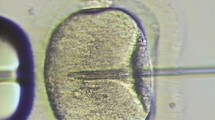Abstract
Purpose
To find out the meiotic segregation behaviour of the t(1;8;2)(q42;p21;p15), to evaluate the occurrence of interchromosomal effects, and to determine whether there is an accumulation of unbalanced products in aneuploid/diploid gametes.
Methods
A sequential FISH protocol based on two successive hybridization rounds over the same spermatozoa was performed to determine the segregation outcome of the rearranged chromosomes. The presence of numerical abnormalities for 13, 18, 21, X and Y was also evaluated by sperm FISH. Those aneuploid/diploid gametes were subsequently relocalized and analyzed for their segregation content through additional hybridization rounds.
Results
The segregation pattern observed reported a very low production of normal/balanced gametes (11.7 %). Significant increased frequencies of diploidies and disomies for chromosomes X/Y and 18 were detected (p < 0.001). Aneuploid and diploid spermatozoa displayed significant increases of 5:1, 6:0 and other unexpected disjunction modes (p < 0.001).
Conclusions
The strategy developed in this study is a reliable new approach to establish the full segregation pattern of complex chromosome rearrangements (CCR). Results corroborate the low number of normal/balanced spermatozoa produced by CCR carriers and support previous findings regarding an altered segregation pattern in gametes with numerical abnormalities. Altogether this confirms the importance of PGD as a tool to prevent the transmission of chromosomal abnormalities to the offspring in CCR patients.



Similar content being viewed by others
References
Anton E, Vidal F, Blanco J. Role of sperm FISH studies in the genetic reproductive advice of structural reorganization carriers. Hum Reprod. 2007;22:2088–92.
Blanco J, Egozcue J, Vidal F. Incidence of chromosome 21 disomy in human spermatozoa as determined by fluorescent in-situ hybridization. Hum Reprod. 1996;11:722-6.
Cifuentes P, Navarro J, Míguez L, Egozcue J, Benet J. Sperm segregation analysis of a complex chromosome rearrangement, 2;22;11, by whole chromosome painting. Cytogenet Cell Genet. 1998;82:204–9.
Coco R, Rahn MI, Estanga PG, Antonioli G, Solari AJ. A constitutional complex chromosome rearrangement involving meiotic arrest in an azoospermic male: case report. Hum Reprod. 2004;19:2784–90.
Escudero T, Estop A, Fischer J, Munne S. Preimplantation genetic diagnosis for complex chromosome rearrangements. Am J Med Genet. 2008;146A:1662–9.
Godo A, Blanco J, Vidal F, Anton E. Accumulation of numerical and structural chromosome imbalances in spermatozoa from reciprocal translocation carriers. Hum Reprod. 2013;28(3):840–9.
Johanisson R, Löhrs U, Passarge E. Pachytene analysis in males heterozygous for a familial translocation (9;12;13) (q22; q22; q32) ascertained through a child with partial trisomy 9. Cytogenet Cell Genet. 1988;47:160–6.
Kim JW, Chang EM, Song S-H, Park SH, Yoon TK, Shim SH. Complex chromosomal rearrangements in infertile males: complexity of rearrangement affects spermatogenesis. Fertil Steril. 2011;95:349–52. 352.e1–5.
Kirkpatrick G, Ma S. Meiotic segregation and interchromosomal effects in a rare (1:2:10) complex chromosomal rearrangement. J Assist Reprod Gen. 2012;29:77–81.
Lejeune J. Autosomal disorders. Pediatrics. 1963;32:326–37.
Lim CK, Cho JW, Kim JY, Kang IS, Shim SH, Jun JH. A healthy live birth after successful preimplantation genetic diagnosis for carriers of complex chromosome rearrangements. Fertil Steril. 2008;90:1680–4.
Loup V, Bernicot I, Janssens P, Hedon B, Hamamah S, Pellestor F, et al. Combined FISH and PRINS sperm analysis of complex chromosome rearrangement t(1;19;13): an approach facilitating PGD. Mol Hum Reprod. 2010;16:111–6.
Lu PY, Hammit DG, Zinsmeister AR, Dewald GW. Dual color fluorescence in situ hybridization to investigate aneuploidy in sperm from 33 normal males and a man with a t(2;4;8)(q23;q27;p21). Fertil Steril. 1994;62:394–9.
Mau-Holzmann UA. Somatic chromosomal abnormalities in infertile men and women. Cytogenet Genome Res. 2005;111:317–36.
Pellestor F, Anahory T, Lefort G, Puechberty J, Liehr T, Hédon B, et al. Complex chromosomal rearrangements: origin and meiotic behavior. Hum Reprod Update. 2011;17:476–94.
Pellestor F, Puechberty J, Weise A, Lefort G, Anahory T, Liehr T, et al. Meiotic segregation of complex reciprocal translocations: direct analysis of the spermatozoa of a t(5;13;14) carrier. Fertil Steril. 2011;7:2433.e17–22.
Saadallah N, Hulten M. A complex three breakpoint translocation involving chromosomes 2, 4, and 9 identified by meiotic investigations of a human male ascertained for subfertility. Hum Genet. 1985;71:312–20.
Sarrate Z, Anton E. Fluorescent in situ hybridization (FISH) protocl in human sperm. J Vis Exp. 2009;31.
Sarrate Z, Vidal F, Blanco J. Role of sperm fluorescent in situ hybridization studies in infertile patients: indications, study approach, and clinical relevance. Fertil Steril. 2010;93:1892-902.
Acknowledgments
This work was supported by the projects SAF2010-22241 (Ministerio de Ciencia e Innovación, España), SGR2009-282 (Generalitat de Catalunya) and UAB CF-180034 (Universitat Autònoma de Barcelona). A.G. is a recipient of a grant FI-DGR 2012 (Generalitat de Catalunya).
Conflict of interest
The authors declare that there are no conflicts of interest.
Author information
Authors and Affiliations
Corresponding author
Additional information
Capsule
The study reveals a low production of normal/balanced gametes in a t(1;8;2)(q42;p21;p15) carrier and supports previous findings related to the presence of an altered segregation pattern in gametes with numerical abnormalities.
Rights and permissions
About this article
Cite this article
Godo, A., Blanco, J., Vidal, F. et al. Sequential FISH allows the determination of the segregation outcome and the presence of numerical anomalies in spermatozoa from a t(1;8;2)(q42;p21;p15) carrier. J Assist Reprod Genet 30, 1115–1123 (2013). https://doi.org/10.1007/s10815-013-0063-5
Received:
Accepted:
Published:
Issue Date:
DOI: https://doi.org/10.1007/s10815-013-0063-5




